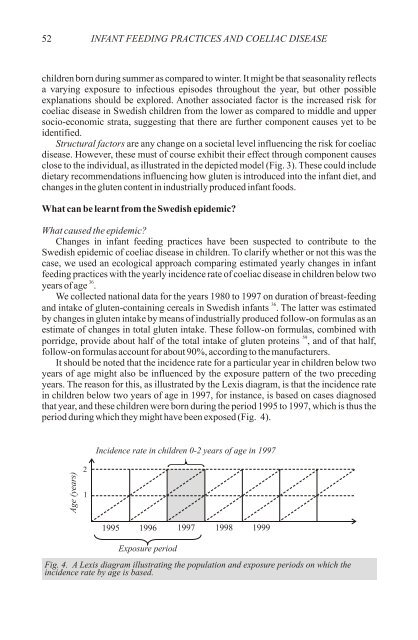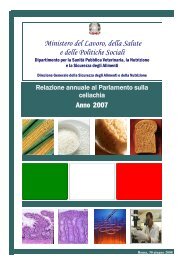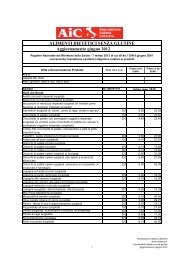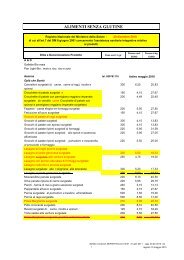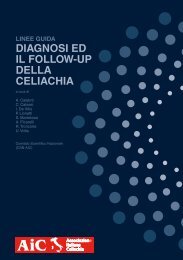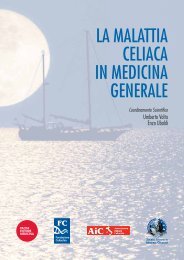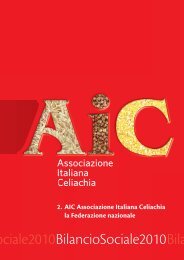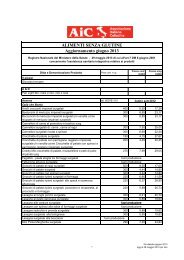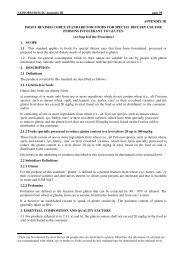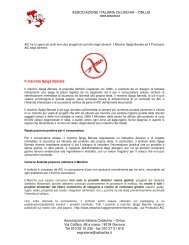primary prevention of coeliac disease - Associazione Italiana ...
primary prevention of coeliac disease - Associazione Italiana ...
primary prevention of coeliac disease - Associazione Italiana ...
Create successful ePaper yourself
Turn your PDF publications into a flip-book with our unique Google optimized e-Paper software.
Age (years)<br />
52 INFANT FEEDING PRACTICES AND COELIAC DISEASE<br />
children born during summer as compared to winter. It might be that seasonality reflects<br />
a varying exposure to infectious episodes throughout the year, but other possible<br />
explanations should be explored. Another associated factor is the increased risk for<br />
<strong>coeliac</strong> <strong>disease</strong> in Swedish children from the lower as compared to middle and upper<br />
socio-economic strata, suggesting that there are further component causes yet to be<br />
identified.<br />
Structural factors are any change on a societal level influencing the risk for <strong>coeliac</strong><br />
<strong>disease</strong>. However, these must <strong>of</strong> course exhibit their effect through component causes<br />
close to the individual, as illustrated in the depicted model (Fig. 3). These could include<br />
dietary recommendations influencing how gluten is introduced into the infant diet, and<br />
changes in the gluten content in industrially produced infant foods.<br />
What can be learnt from the Swedish epidemic?<br />
What caused the epidemic?<br />
Changes in infant feeding practices have been suspected to contribute to the<br />
Swedish epidemic <strong>of</strong> <strong>coeliac</strong> <strong>disease</strong> in children. To clarify whether or not this was the<br />
case, we used an ecological approach comparing estimated yearly changes in infant<br />
feeding practices with the yearly incidence rate <strong>of</strong> <strong>coeliac</strong> <strong>disease</strong> in children below two<br />
36<br />
years <strong>of</strong> age .<br />
We collected national data for the years 1980 to 1997 on duration <strong>of</strong> breast-feeding<br />
36<br />
and intake <strong>of</strong> gluten-containing cereals in Swedish infants . The latter was estimated<br />
by changes in gluten intake by means <strong>of</strong> industrially produced follow-on formulas as an<br />
estimate <strong>of</strong> changes in total gluten intake. These follow-on formulas, combined with<br />
59<br />
porridge, provide about half <strong>of</strong> the total intake <strong>of</strong> gluten proteins , and <strong>of</strong> that half,<br />
follow-on formulas account for about 90%, according to the manufacturers.<br />
It should be noted that the incidence rate for a particular year in children below two<br />
years <strong>of</strong> age might also be influenced by the exposure pattern <strong>of</strong> the two preceding<br />
years. The reason for this, as illustrated by the Lexis diagram, is that the incidence rate<br />
in children below two years <strong>of</strong> age in 1997, for instance, is based on cases diagnosed<br />
that year, and these children were born during the period 1995 to 1997, which is thus the<br />
period during which they might have been exposed (Fig. 4).<br />
2<br />
Incidence rate in children 0-2 years <strong>of</strong> age in 1997<br />
1<br />
1995 1996 1997 1998 1999<br />
Exposure period<br />
Fig. 4. A Lexis diagram illustrating the population and exposure periods on which the<br />
incidence rate by age is based.


